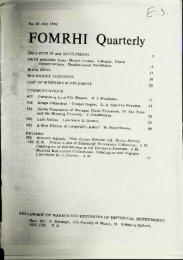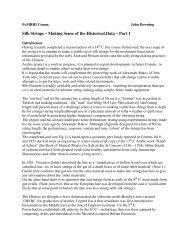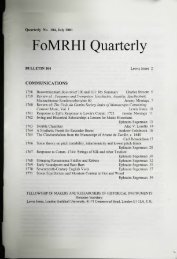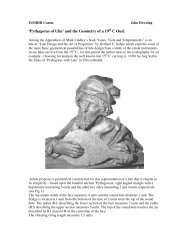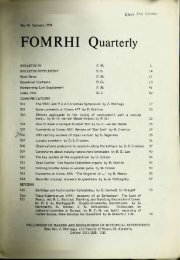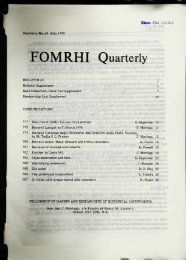•rf - FoMRHI
•rf - FoMRHI
•rf - FoMRHI
You also want an ePaper? Increase the reach of your titles
YUMPU automatically turns print PDFs into web optimized ePapers that Google loves.
PRAETORIUS AND THE VIOLA BASTARDA<br />
D Abbott and E Segerman<br />
Interest in the viola bastarda is growing rapidi}' and it is necessary to correct some<br />
misconceptions which we have heard stated and seen in print before they become too<br />
rooted in the lore of modem early music culture.<br />
Praetorius (1619) (1) gives 5 tunings for the viola bastarda, ali with 6 strings. Some<br />
modem players say that 7 strings are needed to play the music which is typically in<br />
a divided style and often with a range from At to d . They follow Bessaraboff (2)<br />
(1941), p.426, who stated that "a 7-string viola bastarda is represented in a painting<br />
by Domenico Zampieri (Domenicino) ca. 1H20". His identification of this instrument<br />
could be based on the presence of the rose below the fingerboard. Such a rose appears<br />
•n Praetorius's drawing of the viola bastarda and not on his other viols. But Bessaraboff<br />
himself correctly stated elsewhere (p.430) "...a rose is not necessarily the sign of<br />
a viola bastarda... " when arguing against Sachs who stated that it was. The size of<br />
the instrument in the painting,with about 85cm string length;is rather large for the<br />
technical demands of the music and there is no reason to believe that it isnone oiher hhcurì<br />
a particularly large consort bass viol or a particularly small double-bass viol with<br />
an unusually extended range. The earliest mention of 7 strings as a standard vi io1<br />
\U<br />
feature was Rousseau's (3) statement in 1689 that St Colombe introduced the use ;e of |<br />
the 7th string simultaneously with metal-covered strings in about 1675.<br />
Furthermore these modem players argue that Praetorius's 6-string tunings covering<br />
that range are suitable for chords (lyra style) but not for passage work. We shall<br />
later discuss the relationship between the viola bastarda and the English lyra viol but<br />
we will now show how the instrument and its tunings and usage as described by<br />
Praetorius are well matched to surviving viola bastarda pieces.<br />
Figure 1. Praetorius's tunings for the viola bastarda<br />
G> «^ O O rs<br />
&<br />
-/- & &<br />
-Grr<br />
~ > i ~ > £~r<br />
-O O<br />
%• 3. -e- 4. -e- S, -Gr-<br />
Praetorius's tunings 1 and 2 are the same as for the consort bass viol in England.<br />
Tuning 1 is also that of the German consort tenor viol. As Praetorius states (Bessaraboff's<br />
translation p.277), the viola bastarda "is a type of Viola da Gamba, and it must be<br />
tuned as the tenor of the Viola da Gamba (instead of which it can be used in case of<br />
need). But its body is somewhat longer and larger (deeper)". His illustration<br />
(Piate XX no. 4) shows an open string length of 73 cm which, according to our work<br />
on gut-strings (4) just allows an open-string pitch range from A, to d' in Cammerthon<br />
pitch standard which tunings 3, 4 and 5 indicate.<br />
-21-





